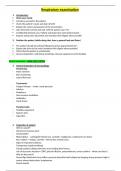Respiratory examination
1. Introduction:
Wash your hands
Introduce yourself to the patient
Check the patient’s name and date of birth
Explain the nature and purpose of the examination
Gain informed consent and wait until the patient says ‘Yes’
Confidential between you, Patient and Supervisor (and medical team)
Enquire about pain, discomfort and maintain their dignity when possible
2. Position the patient (while doing that, have a general look and listen)
The patient should be inclined/sitting forward at approximately 45 o.
Expose the chest to the waist (maintain their dignity when possible)
Check that the patient is comfortable.
General inspection: well-being, breathing, relevant equipment at the bedside.
Always remember - LOOK, FEEL, LISTEN
3. General inspection of surroundings:
Monitoring:
- Pulse oximetry
- ECG monitoring
- Lateral flow test
Treatments:
- Oxygen therapy – masks, nasal speculae
- Inhalers
- Nebulisers
- Non-invasive ventilation
- Antibiotics
- Chest drains
Paraphernalia:
- Mobility equipment
- Sputum pots
- Cigarettes
4. Inspection of patient
- Well or unwell?
- Alertness/conscious level
- Comfortable?
- Body habitus – cushingoid=steroid use, cachetic= malignancy, emphysema or obese
Key; habitus = weight, cachetic = skinny/loss of body mass
- Signs of respiratory distress:
Tachypnoea (rapid breathing)
Tripod position (sitting with their arms holding their knees)
Use of accessory muscles= COPD, pleural effusion, pneumothorax, severe asthma – where are these?
Why do they work?
Pursed lips (think duck face selfie)= prevents bronchial wall collapse by keeping airway pressure high in
severe airway obstruction/ emphysema
Flared nostrils
, - Breathing pattern
- Prolonged expiratory phase= asthma, COPD
- Added breath sounds= wheezing/ stridor= large airway obstruction for example mediastinal masses,
broncal carcinoma, retrosternal thyroid
- Cough; ?dry ?productive? bovine? Colour and volume of sputum
- Noises: speech abnormalities for example in recurrent laryngeal nerve palsy, gurgling= airway
secretions, clicks= bronchiectasis
Cathetic Tripod position
5. Hands
Examine the hands for
Clubbing – look at the finger from the side with your eyes at the same level. Look at the nail bed angle.
Ask the patient to touch R and L nails of both index fingers – is there a gap indicating a normal nail bed
angle? (this gap is also known as Shamroth’s window). Clubbing is caused by infection, inflammatory,
neoplastic and vascular diseases. Common cause is disease of heart or lungs such as lung cancer,
congenital heart defects, chronic lung infections like bronchiectasis, cystic fibrosis, lung abscess,
infection of the lining of the heart like infectious endocarditis or lung disorders with deep tissues being
swollen and scarred such as interstitial lung disease.
Peripheral cyanosis – bluish discoloration of the fingers. Caused by reduced cardiac output secondary to
heart failure or shock. Local vasoconstriction due to cold exposure, hypothermia, acrocyanosis, and
Raynaud phenomenon. Vasomotor instability. Common cause is hypoxia- low oxygen levels.
CO2 retention – arms held outstretched with wrists cocked back for 30-60 seconds show flapping
tremor. Asterixis is an important sign of metabolic encephalopathy that occurs due to dysregulation of
the diencephalic motor centers in the brain that regulate innervation of muscles responsible for
maintaining position. CO₂ retention causes toxicity at these centres.
Fine tremor – Salbutamol/bronchodilator therapy (β2 agonists) induced. the B2 adrenoreceptor agonist
(salbutamol) has a direct effect on the muscles active state this ' leads to incomplete fusion and reduced
tension of tetanic contractions.
Intrinsic muscles of the hand wasting – due to brachial plexus damage (sign of Pancoast/lung cancer)
- dorsal interossei and thenar eminence are the muscles commonly affected, inspect these areas
- (not important to remember the muscle names but good to be aware of the muscles you are looking
out for). Its more evident in 4th and 5th fingers. Causes could be motor neuron disease, spinal cord
compression, syphilis, poliomyelitis and syringomyelia.
Tar staining on the fingers – smokers
Capillary refill-- less than 2 seconds is normal, >2 secs (mora than) in hypoperfusion
Sweaty/ warm/ clammy hands—CO2 retention
Clubbing Peripheral cyanosis Tar staining




